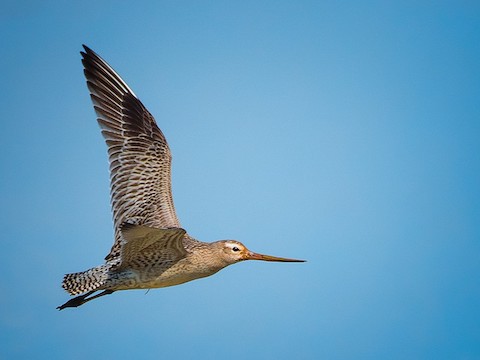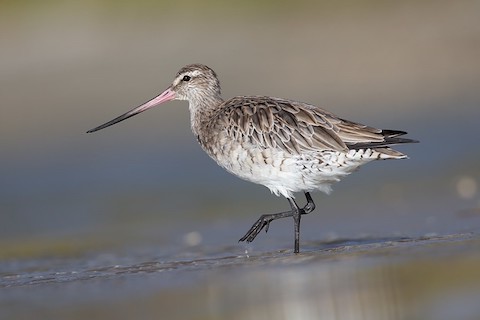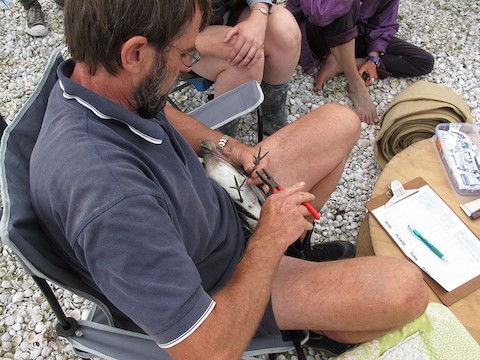
Credit: Kirkamon, via Wikimedia Commons
Many birds fly long distances during their annual migrations. But there’s one species that tops them all.
Some of the farthest flyers are cuckoos, who travel 7,500 miles over 2 months, from Africa to Mongolia, stopping along the way for food and water.
This includes one nonstop stretch over the Indian Ocean for 1,600 miles!
That sounds impressive, but it’s a walk in the park for the bar-tailed godwit.
Godwits are wading birds in the sandpiper family. They spend the mild northern summer along Arctic shorelines. Then, as autumn arrives, they take off for the Southern Hemisphere to skip the winter entirely.
To prepare for this incredible journey, godwits build up huge fat reserves.
They gorge on worms, clams and crustaceans until over half their body weight is fat. Meanwhile, their wing and leg muscles grow larger.
Like other long-distance birds, they may shrink their internal organs, and take “bird naps” while flying, putting half their brain to sleep in short alternating bursts.
Using these tactics, godwits can fly 55 miles an hour for 11 days straight without stopping, crossing nearly 8,000 miles of unbroken ocean from Alaska to New Zealand.
They’ll stay there for 6 months, replenishing fat reserves till fall arrives. Then they’ll take off again, to fly back into the northern spring for mating and nesting.
Now that’s a long-haul round trip!
Background
Synopsis: You may be dreaming about an international trip this fall. Maybe even an ultra-long-haul flight of 7,500 nonstop mi (12,070 km) or more. Some wading shorebirds take trips like that every year. Bar-tailed godwits breed in Alaska until September and then fly nonstop to New Zealand for a summer holiday. While the rest of us were still locked down in 2020, one of them, Godwit 4BBRW, was tracked on his southward migration from Alaska, flying for 11 days and more than 7,500 mi to a bay near Auckland without stopping—and he didn’t have to quarantine on arrival!
- Are you planning an exotic international getaway this year? Ultra-long-haul flights are defined as flights that last for more than 12 hours and cover more than 7,500 mi.
- The first airline to approach that nonstop distance was a Pan American flight from Sydney to San Francisco in December of 1976.
- Today, the longest scheduled direct flight is a 9,534 mi (15,343 km) Singapore Airlines flight from Newark, NJ to Singapore that takes around 18 hours and 30 minutes. A Singapore Airlines test flight from New York to Sydney, Australia took 19 hours and 16 minutes and covered about 9,900 mi (15,932 km), so this record will continue to be broken as technology advances.
- Birds are known to fly long distances during their annual migrations.
- In 2020, a cuckoo named Onon was tracked as it flew more than 7,500 mi (12,070 km), traversing 16 countries on its westward trek from Zambia to Mongolia and stopping along the way for food and water.
- Onon flew at an average of 37 mph (60 km/h), traveling from March 20 to May 26.
- He crossed a 1,600-mi (2,575 km) stretch of the Indian Ocean nonstop.

Credit: JJ Harrison, via Wikimedia Commons
- That’s impressive, but one species of bird, the bar-tailed godwit, completes an entire ultra-long-haul journey every year.
- Bar-tailed godwits (Limosa lapponica) are long-legged wading birds of the sandpiper family that use their long bills for extracting aquatic worms, bivalves and crustaceans from coastal waters.
- They are medium-sized birds, weighing from 7 to 22 oz (200–600 g), with a head-to-tail length of 15 to 16 in (37–41 cm) and a wingspan of 28 to 31 in (70–80 cm).
- During breeding season, their plumage changes from light brown to a range of cinnamon colors.
- Fossil species of Pliocene and Miocene godwits have been found in rocks as much as 6 million years old.
- Today, five subspecies feed and breed along Arctic shorelines in the northern summer. Godwits skip harsh northern winters altogether by flying south in the autumn to the Southern Hemisphere—the original avian endless summer.
- Satellite tracking experiments have demonstrated that the subspecies Limosa lapponica baueri wins the title for the longest annual avian migration, putting them in the ultra-long-haul category.
- Since 2007, researchers have tagged birds that were overwintering in the temperate summer of a bay near Auckland called the Firth of Thames.
- In 2007, they followed the birds’ northward journey but expected the batteries in the transmitters to discharge after a few months. However, one of the tagged female birds, Godwit E7, kept transmitting until she landed back in New Zealand in early September, revealing a shocking 8-day (192 hour) nonstop flight of 7,150 mi (11,500 km) from Alaska.

Credit: Wilma Verburg, via Wikimedia Commons
- More than 70,000 of this subspecies of godwits follow an annual migration pattern.
- As winter closes in on the Southern Hemisphere, most of these well-fed godwits travel more than 6,000 mi (9,600 km) north from New Zealand and Australia to the coast of China along the Yellow Sea to feed again for about a month.
- They fly onward for another 4,000 mi (6,500 km) to reach their nesting grounds along the Bering Sea’s summer shoreline in western Alaska.
- After breeding and nesting for a couple of months, in autumn, the godwits fatten up again on the Alaskan shore.
- Then they fly more than 7,150 mi (11,500 km) directly over the Pacific Ocean to enjoy a second spring and summer season on the Southern Hemisphere beaches in Australia and New Zealand.
- The godwits’ round trip covers more than 17,150 mi (27,600 km).

Credit: Onioram, via Wikimedia Commons
- To prepare for their incredible journey, godwits have to build up huge reserves of fat.
- By the time they depart, these chubby fliers build up layers of fat under their skin that are up to an inch thick, with more fat around their organs. By the time the godwits take off, over half their weight is fat—their equivalent of jet fuel.
- Meanwhile, the godwits’ wing and leg muscles grow larger.
- Like other long-distance birds, they can shrink their internal organs.
- Godwits navigate using the sun, stars and magnetic fields.
- They take advantage of winds to aid their flight segments, timing departures to coincide with predictable tailwinds.
- While unknown for godwits, studies of larger migrating frigate birds have shown that they nap while flying. They put half of their brain to sleep at a time in bursts of about 12 seconds for a total of 42 minutes of sleep per day without landing.
- In 2020, while global travel was limited for most of us, another bird, male Godwit 4BBRW, set another amazing record, flying at speeds of up to 55 mph (89 km/h).
- Knocked offtrack by strong easterly winds, he corrected his path and landed in the same bay he started from months earlier—just 11 days after departing Alaska.
- Godwit 4BBRW’s satellite transmitter recorded 7,987 mi (12,854 km), a truly ultra-long-haul flight. Possible rounding errors dropped the confirmed distance to a still respectable 7,851 mi (12,200 km).
- For the indigenous Maori, the godwit bird is called kuaka, and their annual return marks the return of spring.
- Puzzled that they never saw the birds breeding or nesting, the Maori have an ancient saying: “Who has ever held the egg of the kuaka?”
- Now we know the eggs were always in Alaska.

